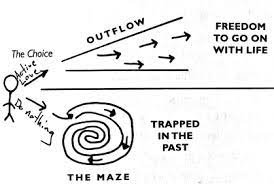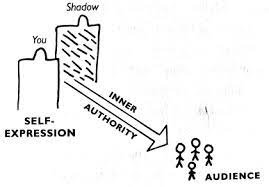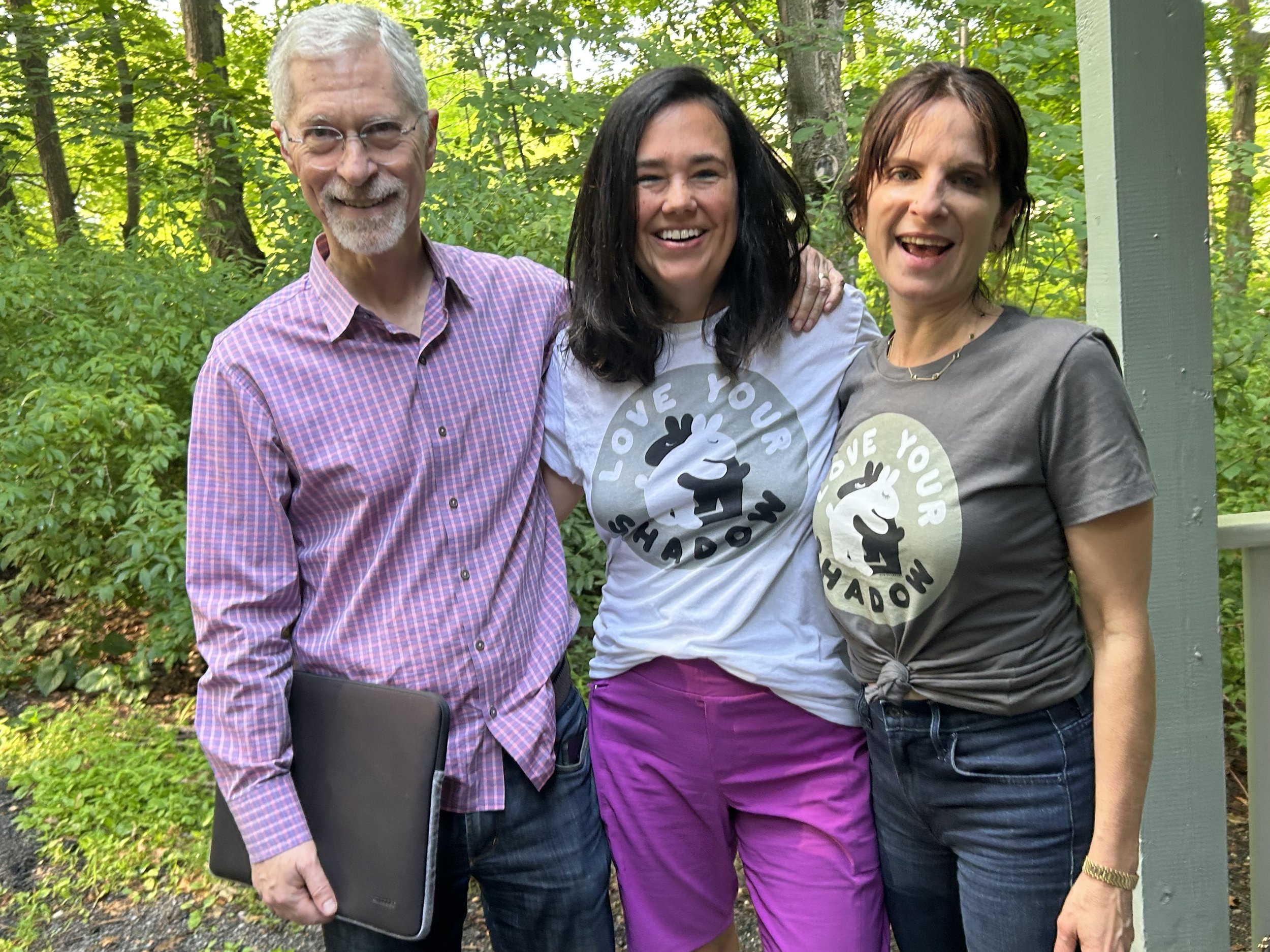Bring It On! The Tools!
The Tools revolutionized my personal growth as well as my coaching practice. After studying with Barry Michels and Kristan Sargeant, students of Phil Stutz, at the Omega Retreat Center in Rhinebeck, New York, I adopted a daily Tools practice and plunged into lots of reading, self-exploration, and research. I learned ways to help myself and clients shift out of debilitating, stuck mindsets into places of empowerment. Simply put, The Tools provide the momentum, clarity and bravery to act from places of renewed strength.*
Phil Stutz and Barry Michels - Key Principles:
In an interview with John Cusack, Stutz explains that, “there are three laws of reality: One, uncertainty, it never goes away. Two, pain, it never goes away. Three, the need for constant effort and work never goes away…..problems and pain of life become the foundation for creating meaning and transformation. You start to see that problems are the instruments of your evolution.”
The authors teach that you are responsible for your own state of mind and mood. You own what you do with injustices or hurts that come your way, “regardless of the environment”. This is essential to finding strength and reclaiming power.
Staying “in your head”, when you are experiencing thoughts that don’t serve you, is not the answer. Connecting to a force that helps you shift out of a negative mindset or pattern is.
You may have heard about The Tools through Jonah Hill’s documentary, Stutz, or Gwyneth Paltrow’s Goop podcast. Stutz and Michels, “shrinks” as they jokingly call themselves, became widely known in the LA area, sought out by creatives who felt immobilized by overwhelm or fear. Luckily, the work is way too good to stay confined to Hollywood. This powerful set of techniques is now recognized all over the world as an impetus towards deeper work, greater clarity and increased life force.
The Tools and Coming Alive:
Stutz and Michels’ New York Times Bestseller book, The Tools, and its sequel, Coming Alive, offer a framework behind these life-changing Tools. Their website, https://www.thetoolsbook.com, provides a gold-mine of information, including videos, audio step-by-step instructions of The Tools and other resources. FaceBook groups, such as The Toolers and The Tools Group, invite like-minded people to come together to ask questions and support each others’ journeys.
Although they acknowledge a time and place for analysis of one’s thinking or behavioral patterns, Stutz and Michels share strategies to help clients get out of mindsets or feelings that do not serve them, such as obsessive thinking, rumination, insecurity and procrastination. This is not about repressing or denying feelings. Instead, it is about getting unstuck from a thinking pattern that is numbing or harmful. It’s about tapping into energies or forces outside of one’s own mind to discover new approaches and momentum.
Despite a resurgence of Star Wars spinoffs, people sometimes resist the idea of “energies or forces”. Coaches and therapists that incorporate The Tools into their practice honor everyone’s unique version of what this means. For some, it may be a religious or spiritual force, repressed but ready-to-come-alive strengths, the power of the universe or earth, or the sudden feeling of ambition or courage that seems to come out of nowhere. For example, Michels talks about feeling “dead” in his previous career and, one day, finding the strength and courage to quit his job. Stutz recounts a football player, not especially huge in size, accessing the courage to tackle an intimidating opponent time and time again. Sports psychology teaches athletes to get out of their head into a space of focus and power. The Tools do the same.
The Tools Book Website:
The Tools and Coming Alive are incredible resources. Readers learn to identify the voice or negative energy inside them, called Part X, that holds them back. This may show up in a thought to skip the gym or as a belief that it would be wrong to stand up to a manipulative friend, even when doing so could shift that dynamic. One of my coaches and mentors, Jamie Rose, a key contributor to the development of and recording of The Tools, encourages users to see way beyond the steps of each Tool to deeper concepts. The book approaches each Tool in the following way:
Cues for when to use the Tool
Steps of the Tool
Forces Invoked with the Tool
Other Uses of the Tool
Frequently Asked Questions
Let’s take a quick look at the first three Tools found in The Tools. There is much more information for each on their website.
Reversal of Desire
Reversal of Desire is helpful when resisting something instrumental to achieving your goals. The goals could be eating a healthy breakfast, asking for a raise, simply clearing out the dishwasher, starting a work project or having a difficult conversation.
The higher force invoked is “forward motion”. The steps help you embrace the discomfort or pain, with a “bring it on!” level of enthusiasm. By going towards the pain, you come out empowered. This is not the same as welcoming unhealthy pain. Instead, this Tool guides you out of your comfort zone in order to conquer fear, stagnation or procrastination.
Check out The Tools or their website, https://www.thetoolsbook.com, for the written and audio versions of the steps of Reversal of Desire!
Phil Stutz’ drawing of
Reversal of Desire
Active Love
Active Love is an empowering alternative to feeling stuck in hurt or anger. It breaks down the walls of what Stutz calls “The Maze”, a state of mind in which you replay past hurts or injustices. It is clear that you are in “The Maze” when you revisit a situation over and over, hear fake arguments in your head or have fantasies of revenge. The Maze keeps you in negative energy, unable to move on and live life fully.
Examples of past hurts might include a parent’s mistreatment, a harsh romantic breakup or an obsequious colleague getting the job when you were the one most qualified.
This Tool does not justify past actions that hurt you. In fact, it does not focus on the actions at all. The Tool redirects you back to yourself, your only real source of power, in order to heal.
The higher force invoked is Outflow. This Tool connects you to a form of love “independent” of your reactions. The steps help you connect to universal love, send it (outflow) to the person in question and feel connected to that person from a place of love. Then, you remove yourself from that connection with all the love intact. From a place of love, you can make a decision without being in The Maze. That decision, coming from a place of greater strength and clarity, could be a more empowered conversation or even confrontation, a breakup or nothing at all. No matter what the result, it will come from a place of strength and clarity instead of from an uncontrolled, overwhelmed state of mind.
Check out The Tools or their website, https://www.thetoolsbook.com, for the written and audio versions of the steps of Active Love!
Phil Stutz’ drawing of
Active Love
Inner Authority
Inner Authority supports you in times of performance anxiety, or when you are focused on the approval of others. When acting from a place of insecurity, it does not make sense to stay in your thoughts. Instead, focus on your core, your true self, and speak from that place inside of you, with no concern for the outcome.
The higher force here is Self Expression. Inner Authority connects you to your Shadow, a part of you that you repressed in order to be accepted or safe. Although you may be ashamed of and want to hide your Shadow, it is a source of authenticity, creativity and wisdom. When you “combine forces” with your Shadow, you speak from a place of authority, a source of true self expression and, ultimately, inspiration.
Many artists benefit from this Tool; it steers them away from paralysis from fear of judgment toward creativity. This can be used to support all types of goals, such as being more authentic with friends, overcoming shyness, and getting to know parts of yourself that society pressured you to neglect.
Some people worry that combining forces with their Shadow will make them more like the part of them they fear. It is actually the opposite. If we don’t connect with our Shadow in healthy ways, this repressed part of ourselves will come out in ways we don’t want, “takeovers” as Stutz calls them. It might come out as jealousy, anxiety, depression, passive aggressive statements, addictions or impulsivity. When you honor and heal the hidden parts or you, you hold the space to truly integrate and heal.
Check out The Tools or their website, https://www.thetoolsbook.com, for the written and audio versions of the steps of Inner Authority!
Phil Stutz’ drawing: Before Use of Inner Authority
Here, the audience is bigger and the Shadow is hidden, leading to a frozen state.
Phil Stutz’ drawing: Inner Authority
With Inner Authority, the Shadow and self connect to work together, leading to authentic self expression.
Working With The Tools:
Working with The Tools can feel a bit abstract or strange at first. It may take many tries to feel a shift. I encourage my clients to use them repeatedly. Initially, some prefer to stick to one Tool at a time, in order to internalize the steps and become more comfortable with it. Others prefer choosing what they feel is the best Tool in the moment. However, there really is no “best” Tool. It is wise to not get caught up in too much analysis and just try one out.
You may also use a Tool with past events to practice the Tool and address lingering feelings that don’t serve you.
It is incredibly helpful to find support with this work. There are many coaches and therapists who incorporate The Tools into their practice. Some of my clients discuss and share experiences from The Tools with friends and families, join the aforementioned Facebook groups, or create a group of their own.
What is most important is consistent use of the Tools. Commitment to a practice that directs you outside of your comfort zone to challenge unhealthy thought patterns and behaviors will lead you to a richer, more fulfilled life. So, what are you waiting for? Use a Tool to get unstuck and buy the book, check out their website, join a group, or find a The Tools Coach today! Bring It On!
Kathleen, studying with Barry Michels and Kristan Sergeant, at a week-long intensive retreat, on the Tools and Shadow Work, at Omega Institute in Rhinebeck, NY.
What life-changing wisdom!
Kathleen Young, Founder of Aurora Lights Coaching, is a personal development and life coach. The Tools is at the foundation of her work. She loves helping clients tap into their strengths and find a purposeful energy that moves them forward.
Bring It On!







